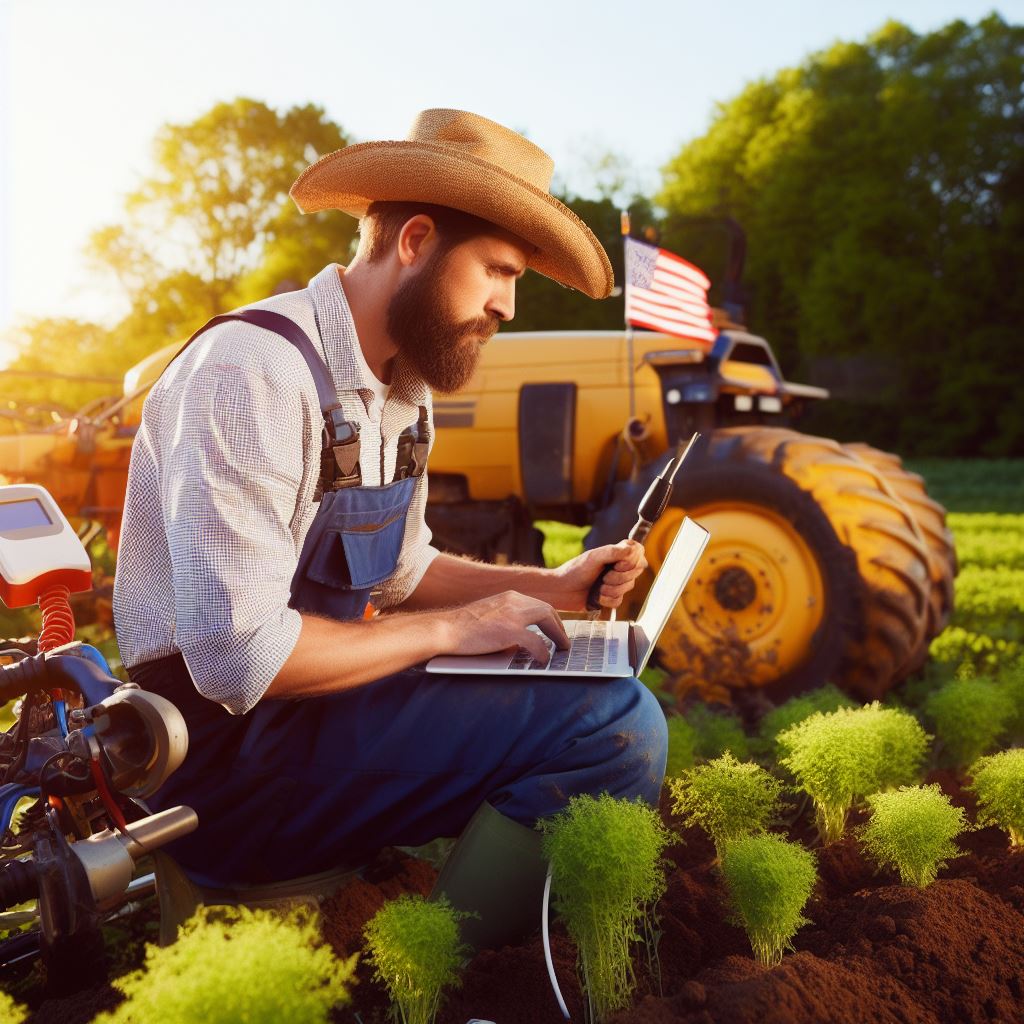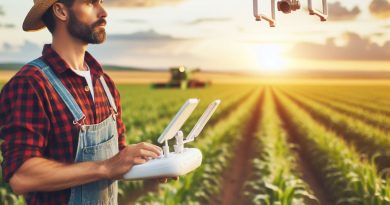Precision Agriculture: Tech in Crop Cultivation
Last Updated on March 2, 2024
Introduction
In today’s modern farming practices, precision agriculture plays a vital role in maximizing crop yields while minimizing resource wastage.
Precision agriculture involves the use of technology and data analysis to make informed decisions about crop cultivation.
Precision agriculture refers to the use of advanced technology, such as GPS, sensors, and drones, to gather data about soil conditions, weather patterns, and plant health.
This data is then used to optimize farming practices for improved efficiency and productivity.
Technology has revolutionized crop cultivation by providing farmers with real-time data on various factors like soil moisture, nutrient levels, and pest infestations.
With this information, farmers can precisely apply fertilizers, pesticides, and irrigation, ensuring optimal crop growth and minimizing unnecessary input usage.
Additionally, technology enables the use of automated machinery and robotics to perform tasks such as seeding, spraying, and harvesting.
These advancements reduce labor costs, improve accuracy, and enable farmers to cover larger areas efficiently.
Moreover, data analytics and predictive modeling allow farmers to make data-driven decisions regarding crop management, such as planting schedules, disease prevention, and yield forecasting.
This helps farmers optimize their operations, reduce costs, and increase profitability.
In short, precision agriculture is a modern approach to crop cultivation that relies on technology and data to maximize yields, minimize resource usage, and improve overall efficiency.
By harnessing the power of advanced equipment and data analytics, farmers can make informed decisions and achieve sustainable agricultural practices for a better future.
Benefits of Precision Agriculture
Precision agriculture refers to the use of technology and data-driven techniques in farming practices.
By utilizing advanced tools and systems, farmers can optimize their crop cultivation processes for better productivity, resource management, and profitability.
Let’s explore the benefits of precision agriculture in detail:
Increased Crop Productivity
- Precision agriculture allows farmers to gather accurate data about their fields, such as soil composition, moisture levels, and crop health.
- By analyzing this data, farmers can make informed decisions on fertilization, irrigation, and pest control, leading to increased crop yields.
- The ability to monitor crop conditions in real-time helps identify and address problems promptly, preventing potential losses.
Efficient Use of Resources
- Precision agriculture helps to precisely distribute water and fertilizers based on the specific needs of each crop and field area.
- Soil moisture sensors and irrigation systems provide data-driven insights, enabling farmers to optimize water usage.
- By applying fertilizers only where necessary, farmers can reduce waste and minimize the risk of environmental contamination.
Reducing Environmental Impact
- Precision agriculture techniques reduce the use of agrochemicals, limiting their release into the environment.
- By accurately applying pesticides and herbicides only where needed, farmers minimize their impact on beneficial insects, biodiversity, and soil health.
- Controlled traffic patterns, made possible by precision guidance systems, prevent soil compaction that can harm the environment.
Maximizing Profit for Farmers
- With precision agriculture, farmers can improve cost-efficiency by reducing input wastage, such as seed, fertilizer, and fuel.
- By optimizing productivity and resource management, farmers can achieve higher crop yields, leading to increased revenue.
- Access to accurate data allows farmers to identify areas with low profitability, enabling them to make informed decisions about land use and crop selection.
In addition to these major benefits, precision agriculture offers various other advantages such as:
- Reduced manual labor: Precision agriculture technologies automate several processes, reducing the need for manual labor while increasing operational efficiency.
- Enhanced data-driven decision-making: Accurate data collection and analysis enable farmers to make informed decisions, improving productivity and minimizing risks.
- Improved sustainability: By using resources more efficiently and reducing environmental impact, precision agriculture contributes to sustainable farming practices.
- Increased competitiveness: Adopting modern farming techniques like precision agriculture helps farmers stay competitive in a rapidly evolving agricultural landscape.
- Enhanced crop quality: By closely monitoring and managing crop health, precision agriculture can improve the quality of harvested produce.
In fact, precision agriculture offers numerous benefits, including increased crop productivity, efficient resource utilization, reduced environmental impact, and maximized profit for farmers.
By embracing advanced technologies and data-driven approaches, farmers can achieve sustainable and profitable crop cultivation while contributing to a more efficient and environmentally conscious agricultural sector.
Technology in Precision Agriculture
The agricultural industry has witnessed remarkable advancements with the integration of technology in precision agriculture.
These technological innovations have revolutionized crop cultivation, increasing efficiency and productivity.
This section explores several key technologies employed in precision agriculture.
Use of Satellite Imagery
Satellite imagery plays a crucial role in precision agriculture.
It enables farmers to monitor large areas of farmland, providing valuable insights and data for decision-making.
By analyzing satellite images, farmers can identify crop health, detect diseases, and pests, and optimize irrigation.
GPS Tracking and Mapping
GPS tracking and mapping have transformed the way farmers navigate their fields.
This technology allows for precise mapping of land boundaries, determining the optimal planting patterns, and implementing variable rate applications.
Farmers can also identify crop yield variations within their fields through GPS tracking.
Weather Monitoring Systems
Weather monitoring systems provide real-time data on temperature, humidity, rainfall, wind speed, and solar radiation.
This information helps farmers make informed decisions regarding irrigation, fertilization, and pest control.
Weather monitoring systems enable proactive measures to be taken to protect crops from adverse weather conditions.
Soil Sensors and Data Analysis
The use of soil sensors in precision agriculture allows farmers to monitor and analyze critical soil parameters.
These sensors measure soil moisture, pH levels, nutrient content, and temperature.
By collecting this data, farmers can adjust irrigation and fertilizer applications to ensure optimal crop growth and health.
Automated Machinery and Drones
Automation has become an integral part of precision agriculture with the introduction of automated machinery and drones.
Automated machines, such as self-driving tractors, enable precise planting, fertilizing, and harvesting.
Drones equipped with high-resolution cameras and sensors provide valuable data on crop health, heat stress, and pest infestation.
Benefits of Technology in Precision Agriculture
- Increased Efficiency: Technology streamlines farming practices, minimizing manual labor and reducing time-consuming tasks.
- Enhanced Productivity: Precision agriculture allows farmers to optimize resource utilization, resulting in higher crop yields and improved profitability.
- Cost Reduction: By utilizing technology, farmers can reduce input costs by implementing precise applications of water, fertilizers, and pesticides.
- Environmental Sustainability: Precision agriculture promotes sustainable farming practices by minimizing the use of inputs and reducing environmental impacts.
- Data-Driven Decision Making: Technology provides farmers with valuable data and insights that enable informed decision-making for better crop management.
Technology has revolutionized the agricultural industry by introducing innovative tools and techniques in precision agriculture.
Satellite imagery, GPS tracking, weather monitoring systems, soil sensors, and automated machinery have become essential components of modern farming practices.
These advancements have significantly improved efficiency, productivity, and sustainability in crop cultivation.
By embracing technology in precision agriculture, farmers can harness the power of data, optimizing their yield and contributing to a thriving agricultural sector.
Read: Cover Crops: Advantages in Crop Management
Satellite Imagery in Precision Agriculture
In the world of precision agriculture, satellite imagery plays a crucial role in monitoring crop health, collecting data, and ensuring successful cultivation.
Let’s dive into how this powerful technology is utilized and the benefits it brings.
Monitoring Crop Health
Satellite imagery offers an invaluable way to monitor the health of crops in precision agriculture.
By capturing images of farmland from space, farmers gain a comprehensive view of their fields’ condition.
This includes factors such as soil moisture, vegetation growth, and potential diseases or pests.
The use of satellite imagery allows farmers to identify any issues early on and take timely action to prevent crop loss.
For instance, if the imagery reveals areas of low vegetation growth due to insufficient watering, farmers can adjust irrigation systems accordingly.
Advantages of Quick and Large-Scale Data Collection
One of the significant advantages of satellite imagery in precision agriculture is the quick and large-scale data collection it enables.
Traditional methods of data collection often involve manual sampling, which is time-consuming and can result in limited data points.
With satellite imagery, farmers can obtain information about their entire field all at once.
This saves time and resources while providing a more accurate representation of crop health.
The ability to collect data on a large scale allows for more robust analysis and better-informed decisions.
Satellite Imagery Applications in Crop Cultivation
Satellite imagery finds various applications in crop cultivation, revolutionizing the way farmers approach agriculture.
Here are some notable examples:
- Precision Irrigation: Satellite imagery helps optimize irrigation by providing insights into soil moisture levels, enabling farmers to water crops precisely as needed.
- Disease and Pest Detection: Early identification of diseases or pest infestations is made possible through satellite imagery. Farmers can take prompt action to contain and treat these issues before they spread.
- Growth Monitoring: Satellite imagery allows farmers to monitor vegetation growth across their fields. This information helps assess crop development and identify areas with potential yield variations.
- Yield Prediction: By analyzing satellite imagery data over time, farmers can predict crop yields more accurately. This assists in managing resources, estimating market demand, and optimizing harvest planning.
- Land Management: Satellite imagery aids in mapping and monitoring land use. It helps farmers make informed decisions about crop distribution, land productivity, and soil conservation.
These applications demonstrate how satellite imagery supports precision agriculture at every stage of crop cultivation, ultimately leading to greater efficiency and productivity.
Satellite imagery is a powerful tool in the domain of precision agriculture.
Its ability to monitor crop health, collect data on a large scale, and enable numerous applications significantly enhances farming practices.
With satellite imagery, farmers can make informed decisions about irrigation, identify diseases and pests early, monitor crop growth, predict yields, and manage land more effectively.
As technology continues to advance, satellite imagery will likely become even more precise and accessible, further revolutionizing the way we cultivate crops.
Embracing this technology is crucial for sustainable and efficient agriculture in the future.
Read: Techniques for Healthy Soybean Growth

GPS Tracking and Mapping in Precision Agriculture
How GPS technology is incorporated in precision agriculture
- GPS technology is used in precision agriculture to accurately track and map fields.
- It involves the use of satellites to determine the precise location and coordinates of farming areas.
- GPS receivers are installed on agricultural machinery and equipment to collect location data.
The benefits of precise tracking and mapping of fields
- Precise tracking and mapping help farmers monitor and manage their fields more effectively.
- It enables the creation of accurate digital maps that show variations in soil conditions and crop health.
- Farmers can identify problem areas and take targeted actions to optimize crop growth and yield.
- It saves time and resources by allowing farmers to precisely apply fertilizers, pesticides, and water.
- Mapping also helps in documenting farming practices, facilitating record-keeping and compliance with regulations.
Examples of GPS application in crop cultivation
- Variable Rate Application (VRA): GPS technology assists in adjusting the application rates of inputs such as fertilizers or pesticides based on field variations.
- Auto-steering: GPS-guided auto-steering systems enable precise navigation of agricultural machinery, minimizing overlaps and gaps.
- Yield Mapping: GPS data is used to create yield maps, which show the production variations across the field.
- Site-Specific Crop Management: Using GPS, farmers can divide fields into smaller management zones and customize operations accordingly.
- Remote Monitoring: GPS enables real-time monitoring and tracking of field activities, even from a remote location.
Overall, the integration of GPS tracking and mapping technology has revolutionized precision agriculture by providing farmers with accurate spatial information about their fields.
By leveraging this technology, farmers can optimize their operations, increase productivity, and minimize environmental impact.
Read: Drip Irrigation: Saving Water in Crop Fields
Weather Monitoring Systems in Precision Agriculture
How weather monitoring systems help farmers make informed decisions
Weather monitoring systems play a crucial role in precision agriculture by helping farmers make informed decisions.
How real-time weather data is essential for crop cultivation
With the availability of real-time weather data, farmers can optimize crop cultivation strategies and maximize their yields.
Examples of how weather monitoring systems contribute to precision agriculture
Let’s explore how these monitoring systems contribute to precision agriculture:
- Enhanced Decision-Making: Weather monitoring systems provide farmers with accurate and up-to-date information about weather patterns and changes in their region.
Armed with this knowledge, farmers can determine the best time to plant, irrigate, fertilize, or harvest their crops. - Pest and Disease Control: Real-time weather data helps farmers monitor pest and disease infestations.
By analyzing temperature, humidity, and wind conditions, farmers can assess the risk of outbreaks and take preventive measures promptly, minimizing damage to crops. - Irrigation Management: Weather monitoring systems aid farmers in managing irrigation efficiently.
By monitoring rainfall, soil moisture levels, and evapotranspiration rates, farmers can determine the optimal amount and timing of irrigation, reducing water waste and increasing crop productivity. - Minimized Crop Losses: By utilizing weather monitoring systems, farmers can anticipate extreme weather events like frost, hailstorms, or heatwaves.
With advance warnings, they can implement protective measures such as covering crops or adjusting planting schedules to minimize crop losses. - Assessment of Growing Conditions: Real-time weather data enables farmers to closely monitor growing conditions throughout the season.
By tracking temperature, humidity, and solar radiation, they can assess if the conditions align with the crop’s requirements and make necessary adjustments to optimize growth. - Predictive Analytics: Weather monitoring systems, combined with artificial intelligence and machine learning, enable predictive analytics in precision agriculture.
Farmers can analyze historical weather data to predict future trends and make data-driven decisions for better crop management strategies.
Weather monitoring systems have proven instrumental in advancing precision agriculture.
By empowering farmers with actionable insights, these systems contribute to sustainable farming practices and improved crop yields.
With the continuous advancements in technology, we can expect even more sophisticated and accurate weather monitoring solutions in the future.
Read: Effective Weed Control in Crop Cultivation
Gain More Insights: Organic Crop Selection Basics
Soil Sensors and Data Analysis in Precision Agriculture
The role of soil sensors in measuring moisture, fertility, and other parameters
Soil sensors play a crucial role in precision agriculture by providing valuable information about the soil composition and its nutrient content.
These sensors are capable of measuring various parameters such as moisture levels, fertility, temperature, and pH.
By accurately monitoring these factors, farmers can optimize irrigation and fertilization practices, leading to enhanced crop growth and minimized resource wastage.
The measurement of moisture levels is especially vital in precision agriculture.
Soil sensors can detect the moisture content in the soil, helping farmers determine when and how much water to apply to their crops.
This information is crucial as overwatering can lead to waterlogging and root rot, while underwatering can result in drought stress and stunted growth.
With soil sensors, farmers can ensure that their crops receive just the right amount of water they need, improving overall water use efficiency.
Fertility is another crucial aspect of soil health that can be monitored using soil sensors.
These sensors can measure the concentration of essential nutrients such as nitrogen, phosphorus, and potassium in the soil.
By accurately assessing the fertility levels, farmers can optimize their fertilizer application, avoiding both under and over-fertilization.
This not only saves costs but also reduces the environmental impact caused by excess or insufficient use of fertilizers.
How data analysis helps farmers optimize irrigation and fertilization
Data analysis plays a vital role in transforming the raw data collected by soil sensors into actionable insights for farmers.
By analyzing the collected data, farmers can identify patterns, trends, and correlations that are otherwise difficult to detect manually.
This analysis helps farmers make informed decisions regarding irrigation scheduling, fertilizer application rates, and crop management strategies.
As a result, precision agriculture becomes more efficient and sustainable.
To optimize irrigation and fertilization practices, farmers can utilize data analysis techniques to develop predictive models.
By combining historical weather data, sensor readings, and crop growth data, these models can accurately predict future soil moisture levels and nutrient requirements.
This enables farmers to plan their irrigation and fertilization schedules in advance, ensuring that crops receive the necessary resources at the right time.
This proactive approach prevents resource wastage and maximizes crop productivity.
Examples of soil sensor and data analysis applications in precision agriculture
Soil sensors and data analysis also find applications in precision agriculture beyond moisture and fertility monitoring.
For instance, sensors can measure soil temperature, allowing farmers to assess the suitability of the soil for planting seeds or transplanting seedlings.
Similarly, pH sensors can provide insights into the soil acidity or alkalinity levels, helping farmers determine appropriate soil amendments for optimal plant growth.
Furthermore, some advanced soil sensors can be used to create soil maps, providing farmers with a visual representation of the soil properties across their fields.
By overlaying these maps with crop growth data, farmers can identify areas with specific soil conditions that might require customized irrigation or fertilization strategies.
This targeted approach ensures that resources are allocated efficiently and potential soil issues are addressed promptly.
In a nutshell, soil sensors and data analysis are essential components of precision agriculture.
These technologies enable farmers to accurately measure soil moisture, fertility, and other parameters, resulting in optimized irrigation and fertilization practices.
By harnessing the power of data analysis, farmers can make informed decisions regarding crop management, leading to improved productivity and resource efficiency.
With the advancements in sensor technology and data analysis techniques, precision agriculture is revolutionizing crop cultivation, paving the way for sustainable and high-yielding agricultural practices.
Automated Machinery and Drones in Precision Agriculture
Automation in precision agriculture has revolutionized the way farmers manage their crops.
With the introduction of automated machinery and drones, tasks like planting and harvesting have become more efficient and accurate.
Additionally, drones have proven to be invaluable in crop surveillance and monitoring.
The advantages of using automation and drones in precision agriculture are many, making them crucial tools in modern farming practices.
The use of automated machinery for tasks like planting and harvesting
Automated machinery has become increasingly popular in precision agriculture due to its ability to perform tasks with precision and accuracy.
With advanced technology, these machines can precisely plant seeds at the perfect depth and spacing, ensuring optimal growth conditions for crops.
Furthermore, automated machinery can also accurately harvest crops, reducing reliance on manual labor and increasing productivity.
This not only saves time but also reduces costs for farmers.
How drones assist in crop surveillance and monitoring
The use of drones in crop surveillance and monitoring has proven to be a game-changer for precision agriculture.
Equipped with high-resolution cameras and sensors, drones can capture detailed images and collect data on crop health, growth patterns, and pest infestation.
This real-time information allows farmers to identify potential issues and take immediate action to rectify them.
By monitoring crops from above, drones can cover large areas quickly, enabling farmers to make informed decisions regarding irrigation, fertilization, and pest control more efficiently.
The advantages of using automation and drones in precision agriculture
The advantages of using automation and drones in precision agriculture are vast.
Firstly, automation helps streamline farming operations, allowing farmers to focus on more critical tasks and make data-driven decisions.
By automating repetitive tasks like planting and harvesting, farmers can save time and allocate resources more efficiently.
This increased efficiency results in higher productivity and ultimately leads to better yields.
Secondly, drones play a crucial role in crop surveillance and monitoring.
By providing real-time images and data, drones enable early detection of crop diseases, pest infestations, or nutrient deficiencies.
By identifying these issues early on, farmers can take immediate action, preventing the spread of diseases and reducing crop loss.
Drones also allow farmers to monitor the effectiveness of irrigation systems and adjust them based on crop needs, ultimately conserving water resources.
Moreover, automation and drones contribute to sustainable farming practices.
With precise planting and harvesting techniques, farmers can minimize waste and optimize the use of resources.
By using real-time data provided by drones, farmers can make informed decisions, reducing the use of fertilizers and pesticides.
This not only reduces the environmental impact but also improves the quality and safety of the final produce.
In summary, automated machinery and drones have become indispensable tools in precision agriculture.
They enhance productivity, streamline farming operations, and enable more sustainable farming practices.
The precision and efficiency offered by automation contribute to better crop yields, while drones provide real-time data for informed decision-making.
With these technological advancements, farmers can maximize their yields, reduce costs, and contribute to a more sustainable future of agriculture.
Conclusion
Precision agriculture is crucial in modern crop cultivation.
It enables farmers to optimize resources, increase yields, and minimize environmental impacts.
Technology plays a vital role in driving the industry forward by providing innovative solutions.
It allows farmers to monitor and manage their fields more efficiently, making data-driven decisions.
By adopting precision agriculture practices, farmers can improve productivity and profitability while reducing costs and the use of chemicals.
Furthermore, precision agriculture contributes to sustainable farming practices by minimizing waste and preserving natural resources.
As technology continues to advance, there will be even more opportunities for farmers to embrace precision agriculture and enhance their farming practices.
It is important for farmers and stakeholders in the agriculture industry to explore and adopt these technologies to stay competitive in the global market.
By harnessing the power of precision agriculture, farmers can revolutionize crop cultivation and contribute to a more sustainable and efficient agricultural sector.


